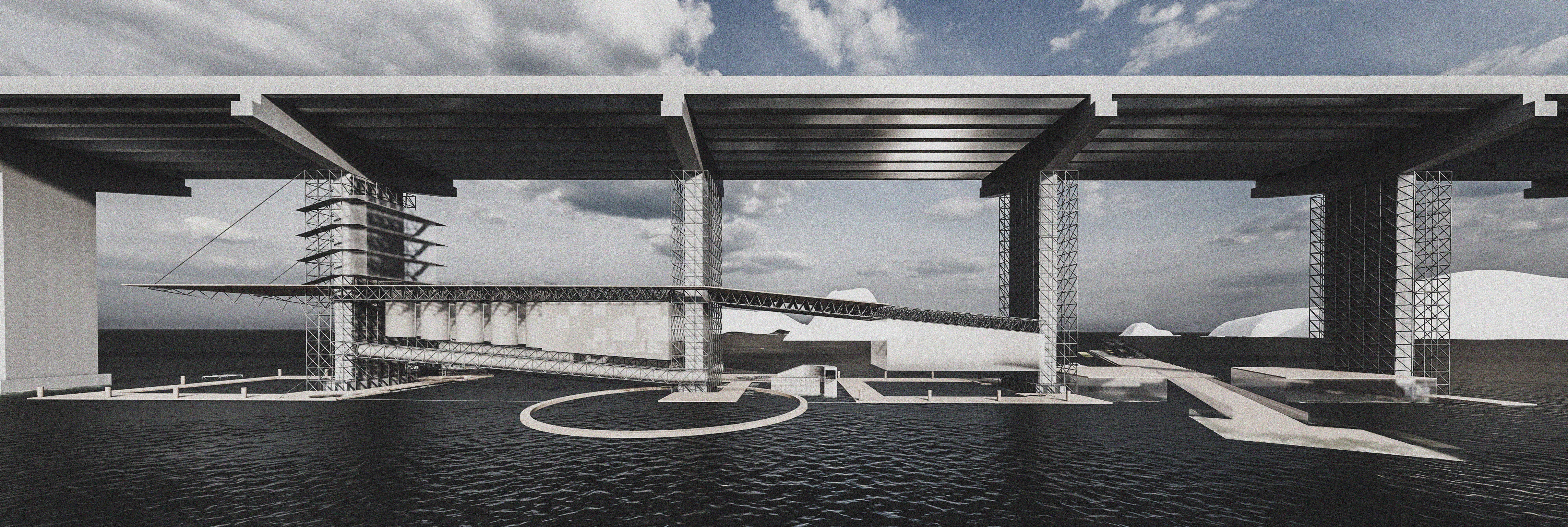3. Territory in Transit

Individual Work/ TU Delft
“Be Water, My Friend.
Empty your mind.
Be formless, shapeless, like water.
You put water into a cup, it becomes the cup.
You put water into a bottle, it becomes the bottle.
You put it into a teapot, it becomes the teapot.
Now water can flow or it can crash.
Be water, my friend.”
Bruce Lee
Empty your mind.
Be formless, shapeless, like water.
You put water into a cup, it becomes the cup.
You put water into a bottle, it becomes the bottle.
You put it into a teapot, it becomes the teapot.
Now water can flow or it can crash.
Be water, my friend.”
Bruce Lee

Through invisible borders drawn within the waterscape, in which cargo ships, oil tankers, passenger engines and fishing boats float generating a landscape of its own, with density and flow. This accumulation of action and pollution transformed the balance of human and nature co-existence. Natural streams through the water created zones of extremely high turbidity rising up to 350 FNU significantly impacted by land reclamation through decades above the basin of delta, opposing its history and generating a conflict. Chlorophyl levels in water decreased threatening marine eco-system and struggling to make water a human-territory. This project initiates by asking the question: do humans belong here?

Current experience of Macao with water can be defined as “detachment”. Through the memory of flood and struggle of residents of the PRD, water has never been part of the happiest memories. The project proposes a new scheme: a territory in progress promoting co-existence of human with the “pearl” of Pearl River Delta: oysters. Generating a neutral space, in which humans do not dominate over nature. The territory is no longer designed for only humans, but promotes restoration of a forgotten tradition, oyster farming for the whole region.

The project does not have a specific location, it rather functions as a machine compose of layers. It will move along the HKZM bridge, expected to be vacant within 100 years. The initiation point is situated in close reference to the archipelago that caused significantly high turbidity within the ocean and aims to make a statement reversing the narrative: from pollution to the ritual of purification of water and leisure.

The space resulting is no man’s land. It isn’t necessarily inviting. It is a new experience of water aiming to make the visitor question his relation with the surrounding. The proposition is a prototype that can be transported within the whole region therefore it is autonomous. Peculiarity of the referential archipelago inspires the project to have an additional dimension of leisure and palimpsest of the urban and ecological experience.

The scheme is composed of three layers: production, recreation and expansion. These layers also have varying paces of activity and duration. An oyster spends 4 weeks on the layer I. A human spends 6-8 hours on layer II. An unit takes 5 years to form. The reef takes up to 10 years to form layer III. Lifespan of the bridge is 100 years. These varying cycles and users overlap within the layers of the machine.

Layer I is formed around production and industrial process of oyster farming. This layer is temporary. Every 10 years moves to the consequent fragment of the bridge spanning 200 meters at a time. Initiates with ships bringing oyster larvae and is finalized by the Michelin restaurant.
Layer II is formed around human interaction and leisure purposes. Varying experiences of water are proposed for the visitor to currently showcase the pollution, yet through time these spaces will transform and will become an observatory space for growing oyster reef under the water and cleaning of water. The axis cutting through linearity of the bridge extends towards the archipelago as continuation of the program with canoeing activities, a port which becomes the only means of arrival to the territory and finally extending to an underwater platform.
Layer III is the most layer of the territory under most rapid transformation with oyster units added simultaneously every hour. This layer is not highly recognizable as one approaches the unit yet it opposes upcoming vacancy of the bridge functioning as a reverse timeline.


Overall, the proposition questions territorialization of water in response to territorialization of land in the Pearl River Delta Region. An autonomous machine not dedicated to production for humans but for nature, transforming infrastructure for travelling into infrastructure for ecological restoration, continuously in transit.